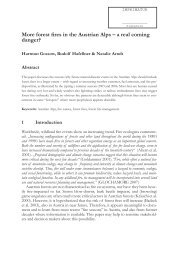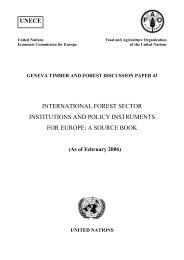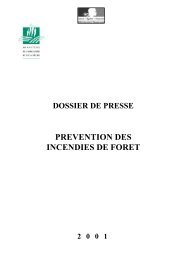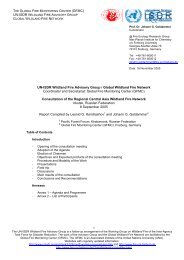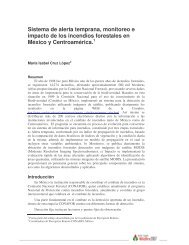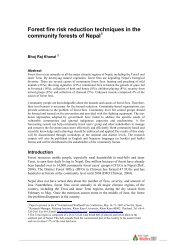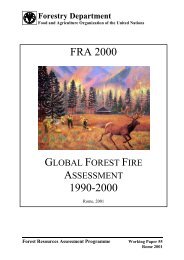Communities in flames - The Global Fire Monitoring Center (GFMC)
Communities in flames - The Global Fire Monitoring Center (GFMC)
Communities in flames - The Global Fire Monitoring Center (GFMC)
Create successful ePaper yourself
Turn your PDF publications into a flip-book with our unique Google optimized e-Paper software.
Preface<br />
Large-scale fires throughout the world <strong>in</strong> recent times have demonstrated the social, economic<br />
and ecological costs of uncontrolled fires and have received unprecedented coverage <strong>in</strong> the<br />
<strong>in</strong>ternational media. To combat the negative impacts, national and <strong>in</strong>ternational agencies have<br />
called for improvement <strong>in</strong> controll<strong>in</strong>g forest fires.<br />
Unfortunately, government responses to forest fires have tended to focus on suppression and<br />
costly technological solutions to fight fires. Contrary to alleviat<strong>in</strong>g forest fire problems, they have<br />
often <strong>in</strong>creased the scale and magnitude of forest fires, and ignored the positive dimensions of fire<br />
<strong>in</strong>clud<strong>in</strong>g the social and ecological benefits of smaller, prescribed burns. <strong>The</strong>se conventional<br />
measures are <strong>in</strong>creas<strong>in</strong>gly be<strong>in</strong>g questioned as the number of forest fires <strong>in</strong>creases.<br />
In addition, decreas<strong>in</strong>g governmental budgets to susta<strong>in</strong> suppression management regimes have<br />
led many agencies to explore more proactive approaches <strong>in</strong> combat<strong>in</strong>g fires before they occur. Over<br />
the last decade, there have been calls to revisit traditional forest fire management regimes, which<br />
emphasise prescribed burn<strong>in</strong>g and prevention. <strong>The</strong>se have been seen as more effective <strong>in</strong> temper<strong>in</strong>g<br />
unwanted fires, more beneficial to local ecosystems and less costly <strong>in</strong> the long term.<br />
In December 2000, Project <strong>Fire</strong>Fight South East Asia and the Regional Community Forestry<br />
Tra<strong>in</strong><strong>in</strong>g <strong>Center</strong> (RECOFTC) organized a regional workshop on community-based fire<br />
management (CBFiM). <strong>The</strong> workshop concluded that successful CBFiM strategies and<br />
experiences should be shared with government agencies to combat the persistent paradigm that<br />
suppression and enforcement are the only effective ways to manage fires.<br />
<strong>The</strong> <strong>Communities</strong> <strong>in</strong> <strong>flames</strong> conference was organized to serve that purpose. <strong>The</strong> objectives<br />
of conference were to:<br />
♦ expose forestry departments/fire control agencies to alternative approaches to forest fire<br />
management, which promote the participation of local communities <strong>in</strong> plann<strong>in</strong>g, and<br />
manag<strong>in</strong>g their own forest fires regimes (with<strong>in</strong> the context of past/traditional practices<br />
and their socio-economic needs of local communities);<br />
♦ exam<strong>in</strong>e the approaches and elements for promot<strong>in</strong>g these alternatives to civil society<br />
(<strong>in</strong>clud<strong>in</strong>g identify<strong>in</strong>g fire research needs, forest policy amendments, legal and<br />
regulatory structures and appropriate strategies for socialis<strong>in</strong>g CBFiM); and<br />
♦ collect examples of the approaches taken by communities worldwide to manage and use<br />
their fires as a resource, and to further clarify and analyse the potential to capture the<br />
opportunities which these alternatives have to offer.<br />
<strong>The</strong>se objectives were pursued through the presentation and discussion of high-quality case<br />
studies and analytical papers from around the world. <strong>The</strong> conference was targeted to present a<br />
synthesis of lessons learned from CBFiM and its benefits <strong>in</strong> mitigat<strong>in</strong>g fires. Among the 120<br />
participants were <strong>in</strong>dividuals and representatives of organizations that have extensive knowledge<br />
and experience of CBFiM, <strong>in</strong>clud<strong>in</strong>g a strong local non-governmental organizational presence.<br />
Representatives from forestry departments and other governmental agencies <strong>in</strong>volved with landuse<br />
plann<strong>in</strong>g, disaster management and fire control also participated <strong>in</strong> large numbers. Academics<br />
and researchers, directly or <strong>in</strong>directly <strong>in</strong>volved <strong>in</strong> fire management-related issues such as land-use<br />
plann<strong>in</strong>g, shift<strong>in</strong>g cultivation and air quality, were also active participants.<br />
iv





